Curiosity #7 What lives at the bottom of Mariana Trench?
Hey there steemit friends, welcome again to our curios article series.
There is one very deep place on our planet. It is called the Mariana trench. You have heard something about it before haven't you?. You may have learned Everest is the highest point on earth and Mariana is the deepest and perhaps that is all you may have learned. But the truth is we cannot even imagine what secrets this place hides and how strange are the creatures that live this deep.
Location and extent of Marian trench: Located in the western Pacific east of the Philippines and an average of approximately 124 miles (200 kilometers) east of the Mariana Islands, the Mariana Trench is a crescent-shaped scar in the Earth’s crust that measures more than 1,500 miles (2,550 kilometers) long and 43 miles (69 kilometers) wide on average. The distance between the surface of the ocean and the trench’s deepest point—the Challenger Deep, which lies about 200 miles (322 kilometers) southwest of the U.S. territory of Guam—is nearly 7 miles (11 kilometers). If Mount Everest were dropped into the Mariana Trench, its peak would still be more than a mile (1.6 kilometers) underwater.
Now about the inhabitants
10. Dumbo Octopus
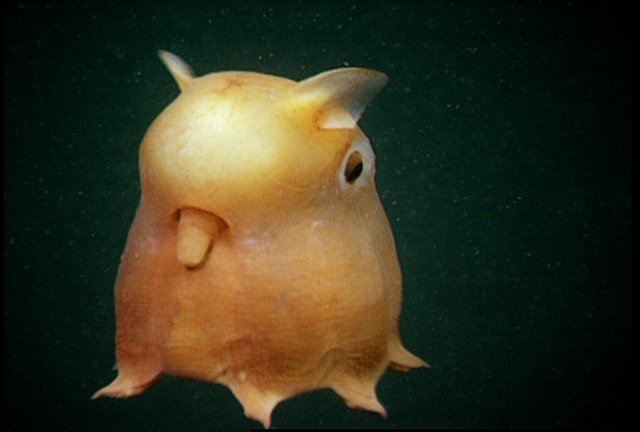
This octopus may look dainty, but it's actually durable enough to make it the deepest dwelling octopus known to science. It prefers to make its home all the way down between 9,800 and 13,000 feet (2,987 and 3,962 meters).When you think of octopuses, you probably envision a bulbous mantle sprouting eight dangly tentacles. The dumbo, however, falls into a category of so-called umbrella octopuses with webbed tentacles that give them, well, an umbrella appearance. The effect is something like a starfish with a balloon head emerging from the center.
9. Deep-sea Dragonfish
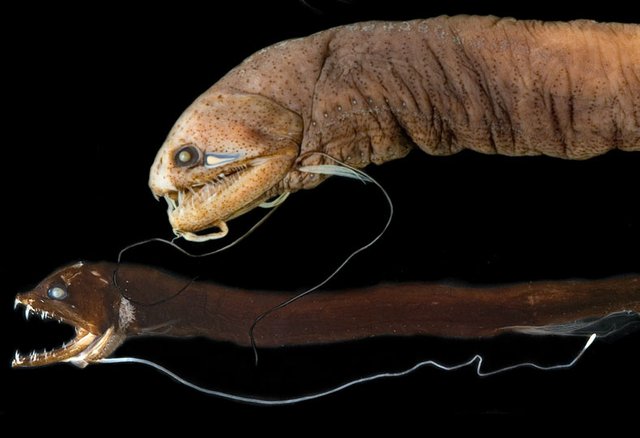
Dragonfish, which are about 6 inches (15 centimeters) long, prefer to swim between 700 and 6,000 feet (213 and 1,828 meters) under the surface, where the waters are lightless and cold. Like many deep-water creatures, this species relies heavily on bioluminescent body parts, which leverage internal chemical reactions to produce an eerie glow.The fish may use this glow to communicate with other fish or to provide camouflage. It also dangles a lighted barbel, or whiskerlike protrusion, from its lower jaw. Other fish are attracted to the barbel, mistaking it for an easy meal. But in a flash, the dragonfish gets lunch instead.Some dragonfish have also evolved the ability to produce a red glow — an unusual color of light for ocean dwellers. They may use their reddish hue to signal their brethren, but it's more likely that they're using the red lamp to illuminate prey just before launching an attack.
8. Barreleye Fish
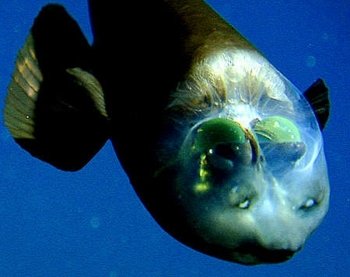
How unusual? Well, for starters, this fish has a transparent head. Inside that head are two sensitive barrel-shaped eyes which are most frequently pointed upwards, allowing the fish to see silhouettes of its prey. As for the clear head, scientists think this feature may simply allow the fish to collect just a little more light, which may give this strange animal a bit more of an advantage over its competition.The barreleye fish wasn't even known to humans until 1939, when it was pulled from its habitat 2,500 feet (762 meters) below the surface. Even then, the specimens were less than ideal because they collapsed in the pressure changes from deep to shallow.Now that researchers have access to deep-diving remotely operated vehicles (ROVs) equipped with lights and cameras that can withstand the pressure, they're able to observe the barreleye more closely. Yet this odd fish still holds many secrets, leaving scientists puzzling over its lifecycle and reproduction patterns.
7. Benthocodon

These are compact jellyfish with a rounded top, called the bell. The bell is typically smaller than three-quarters of an inch to 1.2 inches (2 to 3 centimeters) in diameter, and it's laced with an estimated 1,500 wispy red tentacles, which it uses to whisk itself through the water. The benthocodon dines on small crustaceans and foraminiferans, tiny unicellular organisms.Although many types of jellyfish are transparent, the benthocodon has an opaque reddish coloring on its bell. Scientists believe that this hue may help mask the bioluminescent glow of the tiny animals that the jellyfish eats, hiding the benthocodon from danger.Like so many animals in the trench, this species remains a mystery to scientists.
6. Seadevil Anglerfish

It's hard not to start with the seadevil's looks. As its name strongly hints, this is a fish that could've swum up straight from hell, with its misshapen body, razorlike teeth and cold death stare. Although they're bizarre and scary looking, at least they're not huge. Females generally top out at 8 inches (20 centimeters) long. The males are much smaller, at maybe an inch (2.5 centimeters) long.In a strange evolutionary twist of reproduction, the males actually fuse themselves to the females. Their fins, teeth and eyes disappear, along with a few internal organs, ultimately turning the two individuals into one. What's left of the male's body essentially becomes a storage tank for sperm that will help fertilize the female's eggs when the time is right.As an anglerfish, the seadevil doesn't dart after it prey. Instead, it has a protrusion from its forehead that dangles a glowing lure to attract starstruck, luckless animals. With its huge, gaping jaws, the seadevil can actually devour creatures larger than itself.
5. Goblin Shark
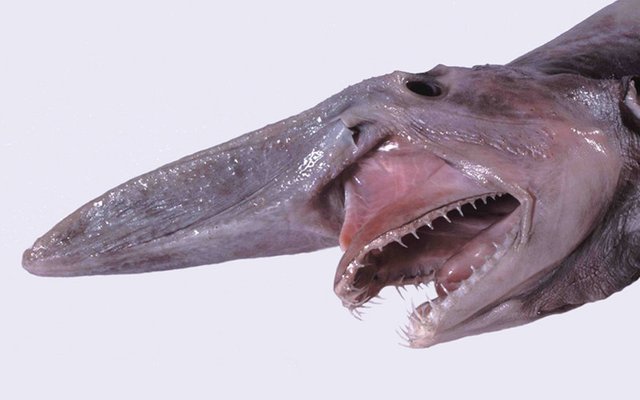
Goblin sharks have a protruding snout that looks like a pointy sword. Just below the snout are a set of protruding jaws that appear to be mismatched for the shark's face, as if evolution spun the wheel of ugly and the goblin shark lost in the worst possible way. What's more, these sharks aren't your stereotypical gray color. Instead, their skin has a distinct pink hue.If you're ever in the water when a goblin shark passes by, you'll find yourself dwarfed in size — they can grow as big as 18 feet (5.5 meters) in length. Fortunately, you're unlikely to encounter such a beast. These sharks typically cruise way down to 3,000 feet (914 meters), and the older they get, the deeper they dive.As with a lot of deep-sea animals, science knows very little about goblin sharks. No one knows exactly how they reproduce, and a pregnant female has never been captured. So like the goblins of fairy tales, these fish remain a mysterious and fantastic example of just how diverse life on Earth can be.
4. Deep-sea Hatchetfish
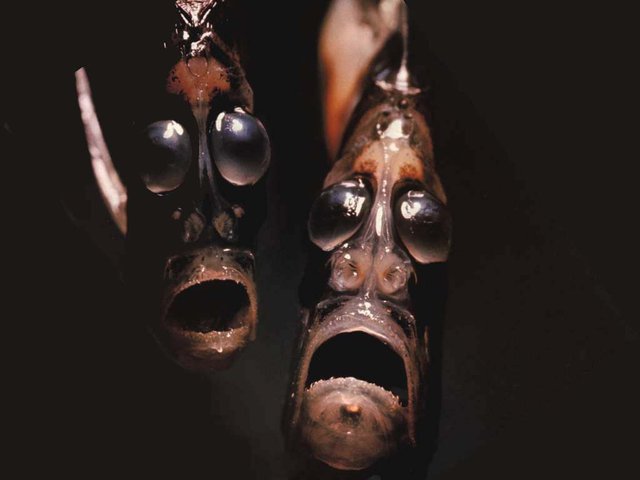
There are more than 40 species of hatchetfish. All of them have ridiculously skinny bodies, and many of them have shiny scales, too, which adds to the metallic, hatchetlike appearance. They're small fish, and even the biggest types grow only to about 6 inches (15 centimeters) long. Their delicate looks belie serious ruggedness, because these fish are found in depths pushing nearly 5,000 feet (1,524 meters).Hatchetfish have bioluminescent bodies, and they can alter the brightness of their glow depending on how much light is filtering from above. In doing so, they're counterilluminating their bodies in a clever camouflage technique. Their dim, self-produced light reduces their silhouettes, making it much more difficult for predators to spot them from below.
3. Frilled Shark
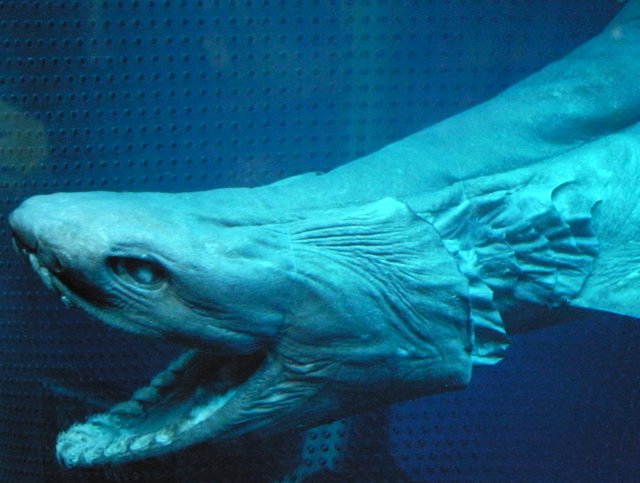
The shark derives its name from six rows of frilly gills that grace its body, which grows up to 6 feet (1.8 meters) long. Just as notably, the shark wields more than 20 rows of wicked, trident-shaped teeth that will tear into any bit of flesh that passes near them.Frilled sharks probably spend most of their lives near the ocean's bottom, and they like waters more than 4,000 feet (1,219 meters) deep. On the rare occasions that people snag them and bring them to the surface, the sharks almost always perish immediately, making it very difficult for us to observe their behavior and lifecycles.For years, many people assumed that frilled sharks swam and hunted like eels. Some researchers think an awkward arrangement of internal organs would make that kind of movement impossible. Instead, they say, these sharks may actually strike their prey with the action of a land-based snake, making them even weirder.
2. Telescope Octopus
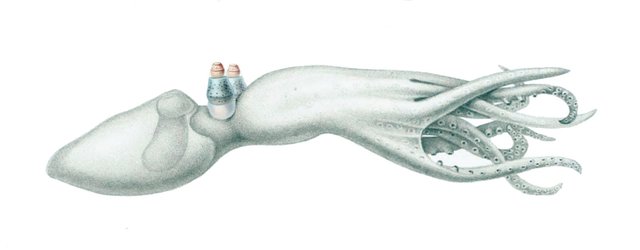
If you were lucky enough to spot a telescope octopus, you'd probably wonder if the underwater pressure was making you see things. Its body is so clear that it's nearly transparent, and between each of its eight tentacles is a delicate webbing that lends this species a ghostly shape.In that cellophanelike flesh, you'll see two protruding eyeballs unlike those found in other octopuses. These eyes provide wider peripheral vision so that the octopus can see predators and prey alike. Like something out of a sci-fi movie, those eyes also rotate, perhaps offering the creature an even better way to see through the darkness of its deep haven.
1. Zombie Worms

The zombie worm secretes acids to help it access the inner contents of those dead whale bones. Then, it uses symbiotic bacteria to convert the bone's proteins and fats into nutrients that serve as its food. Its feathery "branches" wiggle in the water, pulling in oxygen to keep the worm alive.Female zombie worms can grow up to around 2 inches (5 centimeters) long. The males are microscopic by comparison, and females will collect a male harem of these tiny guys on their bodies. Eventually, the males find their way into the female's oviducts. The female releases her fertilized eggs into the water, the worm's lifecycle begins anew, and the zombie worms go about their business of cleaning up whale debris in the ocean's darkest corners.Thanks to better technologies, we humans have finally begun to peer into the blackness of the Mariana Trench. Still, this underwater canyon is one of the most unexplored places on our planet, and it will likely remain so until we find new ways to peer into the depths without risking being crushed or drowned (or breaking our research budgets).
So like the trench itself, the animals that live there will continue to be mysteries, too. They may be our Earth cousins, but considering how little we know about them, they might as well be from another world.
Hope you liked our article. If you liked it then do follow us, we will be posting interesting content on daily basis.
Other posts from @curiousity